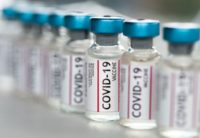How to prepare for COVID-19 Vaccination Requirements

By December 8, 2021, all federal government contractors must be fully vaccinated against COVID-19. According to the guidance, contractors are required to obtain documentation on every employee’s vaccination status. Meanwhile, private sector employers with 100 or more employees will more than likely be required to uphold the same standard.
Even prior to recent mandates, essential businesses were requiring workers and subcontractors to be vaccinated. For example, hospitals required general contractors to ensure workers and subcontractors were vaccinated before the start of any construction projects. From an administrative point of view, this is challenging.
It’s not about politics or foisting an employer’s beliefs on employees. Rather, it’s about the logistical process of verifying and documenting that every employee and subcontractor working onsite has been vaccinated, or that negative test results are current, without disrupting the work to be done.
Thinking back to the beginning of the pandemic, there were lots of lessons learned when it came to documenting employee health. Daily face-to-face health screenings for essential workers took hours. The answers were often handwritten on paper or filled out on PDFs and input into spreadsheets or stored in filing cabinets. Along with the potential for illegible writing, human error and heightened risk of infection, this process made timely contact tracing nearly impossible.
For any business that’s just now determining how to document vaccination verification, they should consider some of the solutions that have been refined over the past 18 months.
Lessons learned from essential businesses
At Ampirical, we’re an essential business that provides electrical transmission, distribution and engineering services as well as construction services. At the beginning of the pandemic, we initiated policies based on CDC guidelines and used a two-step process to ensure safety.
For employees entering the office, we use a temperature screening technology that also features facial recognition and connects data to HR and building security. The second step is to have employees and contractors complete a digital check-in via a web app. They privately answer health screening questions on their smartphone and managers are only alerted if someone has not been approved to enter the office or job site.
For organizations that immediately instituted work-from-home policies, tracking vaccination verification once employees return to work, either full-time or on a hybrid schedule, is a new challenge. To save time, keep employee data private, and have an additional level of safety, here are three recommendations for rolling out a company- wide vaccination verification process.
Don’t use paper based forms or a PDF template to document employee vaccination status. The process will be more time consuming than you anticipate and makes it difficult to easily prove what percentage of the workforce has been vaccinated.
Verify vaccination based on authentic CDC cards. The guidance states that employee attestation is not sufficient to meet OSHA requirements. Employees must show proof of vaccination through CDC cards. To streamline the process, consider using a digital check-in app that allows employees to upload a photo of their vaccination card and securely attach it to their digital check in record. They only need to upload it once and it provides the employer with the necessary documentation. It gives project managers additional insight for employee assignments based on workload and accommodating social distancing, if necessary.
If you can’t do a two-step verification process such as temperature checks tied to HR and security and digital check-in, opt for digital check in. Not only is this a fast and secure way to verify vaccination, there are additional post-pandemic benefits. For example, you have a digital record of hours worked for invoicing and billing. You can also analyze productivity by project and employee or subcontractor. And as an additional safety tool, you can always quickly know who is or was onsite at any time.
As companies with federal contracts prepare for the December deadline, private businesses are also getting ready. And it’s not just businesses with 100 or more employees. In anticipation of additional mandates or client requirements, businesses of all sizes are now taking steps to document who has been vaccinated.
They know the urgency could be stepped up if OSHA institutes an Emergency Temporary Standard requiring immediate documentation of vaccination status for any business that falls under its requirements.
To save time, improve safety, and increase productivity, businesses need to establish processes now to verify vaccination so they can quickly respond to mandates and customer requirements. The most effective way to do this is by taking advantage of newer technologies such as those that link security systems with HR as well as digital check in apps that make it easy to ask the question once and maintain secure digital records that are easy to access.
Looking for a reprint of this article?
From high-res PDFs to custom plaques, order your copy today!









